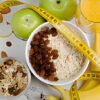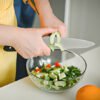Researchers from the University of North Carolina at Chapel Hill analyzed three government surveys taken over two decades and reviewed answers to the average portion size consumed for specific foods, such as snacks, desserts and soft drinks. They also looked at whether the eating was done at home or out.
“Between 1977 and 1996, food portion sizes increased both inside and outside the home for all categories except pizza,” Samara Joy Nielsen and Barry M. Popkin write in the Journal of the American Medical Association.
According to the study, Americans are eating per portion, on average:
- 93 more calories from salty snacks, such as potato chips, pretzels and popcorn.
- 49 more calories from soft drinks.
- 97 more calories from hamburgers.
- 68 more calories from French fries.
- 133 more calories from Mexican food, such as burritos, tacos, enchiladas.
“The most surprising result is the large portion-size increases for food consumed at home – a shift that indicates marked changes in eating behavior in general,” the researchers reported.
Americans’ waistlines are keeping up with the portion increase trend. Nearly 60 percent of the country is overweight, with the numbers growing, said the Centers for Disease Control and Prevention.
“Clearly the problem is that Americans are eating too much food,” Popkin said. “The shifts in where we are eating, as well as the types of food and how much, are critical.”
Food Portion Sizes – Distortion
Nutrition experts said the study confirmed what many thought: Americans aren’t aware of how much they’re eating.
“We’re getting so used to eating out and used to (restaurants’) portion sizes,” said Lisa Drayer, a registered dietician and director of nutrition services with Dietwatch.com. “We’re getting a distorted view of what portion sizes are. We’re not likely to make a distinction between restaurant sizes and real sizes when going home.”
Food Portion Sizes – Effects of Supersizing
“An extra 10 calories per day translates to one pound gained per year,” Drayer explained. “So you can see how all of these calorie increases combined can translate to weight gain over the long-term.”
The most important thing, according to Drayer, is to be able to eyeball portion sizes and know how much you are really eating. They key is to relate portion sizes to every day objects.
For example, the USDA food pyramid recommends an average American consume 5-7 servings of vegetables. But just what is a serving? Drayer says if you remember that a fruit serving looks like a tennis ball, you can get a better idea of what you’re putting away at the table.
According to a 2002 American Dietetic Association survey, Americans tend to overestimate the recommended serving sizes for many foods. Fewer than half of the respondents accurately estimated the recommended serving sizes of pasta, meat or vegetables.
Food Portion Sizes – Supersizing Restaurant
Also, watch out for the “more is better” mentality, especially at fast food restaurants.
“We’re often encouraged to buy larger-sized portions and ‘value meals’ because they provide a better value for our money,” Drayer says. “But while these oversized portions may be good for our wallets, they are not necessarily good for our waistlines or our health.”
Portion Control
What are other ways to avoid portion distortion? Here are some other tips to slim down portions at home, according to Drayer and the American Dietetic Association:
- Beware of unconscious eating. “This is where we’re not aware of how much food we’re putting in our mouths,” Drayer said. “We snack more, we’re eating by ourselves, in front of the TV or talking on the phone.”
- Use smaller plates. You won’t be tempted to fill up all the space of a big platter with extra food you don’t need.
- Serve yourself what you would normally dish out, but then cut everything in half and save the rest for lunch the next day.
- “Kill the plate,” or make whatever is left on the plate unavailable to nibble on, whether it’s a napkin across the food, or, in an extreme move, pouring salt over the leftovers.
For Lasting Weight Control
If you want to lose weight for life, follow Anne Collins Weight Loss Program. It’s PACKED with easy menus, “brilliant” weight loss tips, plus information on exercise and diet nutrition. The BEST VALUE weight loss diet program on the Net!
Return to Weight Loss Articles










